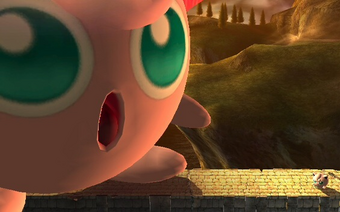Glitch: Difference between revisions
(Anyone wanna expand this paragraph?) |
No edit summary |
||
| Line 18: | Line 18: | ||
[[Category:Glitches (SSBM)| ]] | [[Category:Glitches (SSBM)| ]] | ||
[[Category:Glitches (SSBB)| ]] | [[Category:Glitches (SSBB)| ]] | ||
[[Category:Glitches (SSB4)| ]] | |||
Revision as of 20:13, September 26, 2014
- For a list of all articles on glitches, see Category:Glitches.

A glitch is an oversight of programming of a video game and how it may act in some circumstances. They alter gameplay by causing things to happen that were not intended by the game's designers. The main reason for a glitch existing is that a specific situation resulting in unusual behaviour was never encountered during a game's testing, so the developers are unaware there is something that needs to be fixed. For example, the regenerating terrain glitch likely exists because the situation of "terrain appears around character using Final Smash" was not fully tested by the developers. The more complex a game is, the more likely gitches are to exist, simply due to the increased difficulty in testing every possible situation.
Effects that glitches cause can vary. Glitches can be harmful, with such side effects as freezing the game, causing a level to be unplayable, or KOing a player for no apparent reason. Not all glitches have negative side effects, however; some just allow the player to continue playing the game as usual, such as the Black hole glitch, while other can merely be done for fun, such as the Name Entry glitch and all of its variations. Some can even be considered helpful in some ways, such as the regenerating terrain glitch on Jigglypuff and R.O.B.
In competitive play, most glitches cannot be combined with a player's ordinary tactics in tournaments; a majority of glitches require prerequisites that are unattainable in a tournament setting, such as items, Final Smashes, more than two players, etc., or just simply have entirely useless effects. When it comes to the legality of performable glitches however that can have a practical effect, they are generally allowed to be used, as they are percieved to add to the afflicted characters' metagames (the Teleport in Smash 64 and Yoyo glitch in Melee are prominent examples of glitches with competitive utilisation). Glitches that break the game however and make a match unplayable, such as by freezing opposing characters or making the user invincible, are universally banned from being used in tournaments; the Freeze glitch in Melee and the Infinite Dimensional Cape in Brawl are the two most notorious examples of game breaking glitches that were immediately banned from tournaments when discovered.
Super Smash Bros. for Nintendo 3DS is constantly updated with new bug fixes and features, meaning that all glitches will eventually be fixed as they are discovered.
A glitch is not to be confused with an exploit, though the two terms can be hard to distinguish and are often used interchangeably. Exploits most commonly refer to mechanics and interactions that work as intended seperately, but when combined result in an unintentional effect. Wavedashing is a notorious exploit.